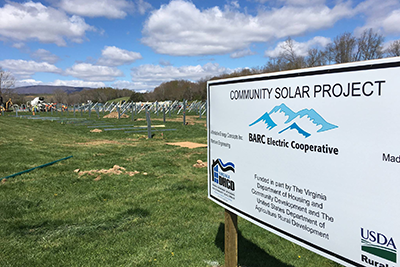
NRECA’s three-year program, Achieving Cooperative Community Equitable Solar Sources (ACCESS), will research financing mechanisms, program designs and engagement strategies to equip electric cooperatives with the tools they need to successfully develop solar projects that benefit LMI consumers.
“Solar energy is an integral part of the electric cooperative fuel mix, but it remains out of reach for many low-income consumers,” said Jim Spiers, Senior Vice President of Business and Technology Strategies at NRECA. “We’re excited to work toward solutions that address this challenge, particularly because electric co-ops often serve higher percentages of LMI consumers, including 92 percent of the nation’s persistent poverty counties. The ACCESS program will leverage the experience gained through innovative cooperative initiatives to make solar energy accessible to LMI consumers.”
Six electric co-ops will participate in the program, using financing mechanisms and program designs to target the benefits from their solar projects to LMI members in their communities:
Anza Electric Cooperative’s SunAnza project is a 4 megawatt (MW) photovoltaic solar array and battery energy storage system. The project will serve the residents of a tribal community and other low-income consumer-members in the Anza service area.
Oklahoma Electric Cooperative is building a solar farm in partnership with Norman, Okla., public schools that will reduce the school district’s energy costs. When complete, the 15-acre, 2 MW solar farm is expected to generate the equivalent of nearly 30 percent of the school district’s total energy usage. Roughly half of students in the district qualify for free or reduced-price school meals.
Orcas Power & Light’s project is a 1.25 MW community solar installation connected to a battery energy storage system. Objectives of the project include reducing barriers to solar energy access and expanding local energy independence and resiliency. A portion of the solar array will be dedicated to benefit low-income members.
Roanoke Electric Cooperative’s SolarShare strategy explores how to leverage the co-op’s energy efficiency upgrades program with its community solar initiative to benefit members who struggle to pay their bills. The cooperative is exploring philanthropic partnerships to help provide access to savings through community solar subscriptions.
BARC Electric Cooperative and Kit Carson Electric Cooperative also have joined the ACCESS project and will identify and launch their initiatives in the coming months.
Supporting NRECA and the six co-ops on the ACCESS team are:
- National Rural Utilities Cooperative Finance Corporation (CFC) and CoBank, which will help identify LMI funding strategies
- GRID Alternatives, a non-profit organization that makes renewable energy technology and job training accessible to underserved communities; and
- Pacific Northwest National Laboratory, which will lend its scientific and technical expertise to the program.


